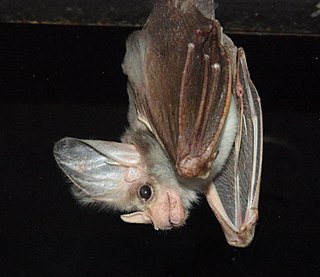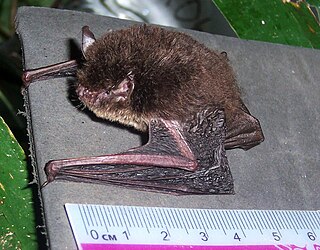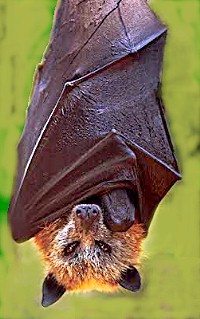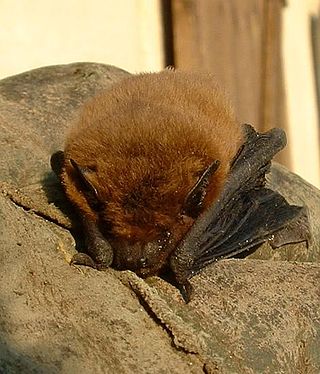
Microbats constitute the suborder Microchiroptera within the order Chiroptera (bats). Bats have long been differentiated into Megachiroptera (megabats) and Microchiroptera, based on their size, the use of echolocation by the Microchiroptera and other features; molecular evidence suggests a somewhat different subdivision, as the microbats have been shown to be a paraphyletic group.

Megabats constitute the family Pteropodidae of the order Chiroptera (bats). They are also called fruit bats, Old World fruit bats, or—especially the genera Acerodon and Pteropus—flying foxes. They are the only member of the superfamily Pteropodoidea, which is one of two superfamilies in the suborder Yinpterochiroptera. Internal divisions of Pteropodidae have varied since subfamilies were first proposed in 1917. From three subfamilies in the 1917 classification, six are now recognized, along with various tribes. As of 2018, 197 species of megabat had been described.

Vespertilionidae is a family of microbats, of the order Chiroptera, flying, insect-eating mammals variously described as the common, vesper, or simple nosed bats. The vespertilionid family is the most diverse and widely distributed of bat families, specialised in many forms to occupy a range of habitats and ecological circumstances, and it is frequently observed or the subject of research. The facial features of the species are often simple, as they mainly rely on vocally emitted echolocation. The tails of the species are enclosed by the lower flight membranes between the legs. Over 300 species are distributed all over the world, on every continent except Antarctica. It owes its name to the genus Vespertilio, which takes its name from a word for bat, vespertilio, derived from the Latin term vesper meaning 'evening'; they are termed "evening bats" and were once referred to as "evening birds".

Kitti's hog-nosed bat, also known as the bumblebee bat, is a near-threatened species of bat and the only extant member of the family Craseonycteridae. It occurs in western Thailand and southeast Myanmar, where it occupies limestone caves along rivers.

Horseshoe bats are bats in the family Rhinolophidae. In addition to the single living genus, Rhinolophus, which has about 106 species, the extinct genus Palaeonycteris has been recognized. Horseshoe bats are closely related to the Old World leaf-nosed bats, family Hipposideridae, which have sometimes been included in Rhinolophidae. The horseshoe bats are divided into six subgenera and many species groups. The most recent common ancestor of all horseshoe bats lived 34–40 million years ago, though it is unclear where the geographic roots of the family are, and attempts to determine its biogeography have been indecisive. Their taxonomy is complex, as genetic evidence shows the likely existence of many cryptic species, as well as species recognized as distinct that may have little genetic divergence from previously recognized taxa. They are found in the Old World, mostly in tropical or subtropical areas, including Africa, Asia, Europe, and Oceania.

Emballonuridae is a family of microbats, many of which are referred to as sac-winged or sheath-tailed bats. They are widely distributed in tropical and subtropical regions around the world. The earliest fossil records are from the Eocene.

The patagium is a membranous body part that assists an animal in obtaining lift when gliding or flying. The structure is found in extant and extinct groups of flying and gliding animals including bats, birds, some dromaeosaurs, pterosaurs, gliding mammals, some flying lizards, and flying frogs. The patagium that stretches between an animal's hind limbs is called the uropatagium or the interfemoral membrane.

The ghost bat is a species of bat found in northern Australia. The species is the only Australian bat that preys on large vertebrates – birds, reptiles and other mammals – which they detect using acute sight and hearing, combined with echolocation, while waiting in ambush at a perch. The wing membrane and bare skin is pale in colour, their fur is light or dark grey over the back and paler at the front. The species has a prominent and simple nose-leaf, their large ears are elongated and joined at lower half, and the eyes are also large and dark in colour. The first description of the species was published in 1880, its recorded range has significantly contracted since that time.

Natterer's bat is a European vespertilionid bat with pale wings. It has brown fur tending to greyish-white on its underside. It is found across most of the continent of Europe, parts of the Near East and North Africa. It feeds on insects and other invertebrates which it catches on the wing or pursues on the ground.

The white-winged vampire bat, a species of vampire bat, is the only member of the genus Diaemus. They are found from Mexico to northern Argentina and are present on the islands of Trinidad and Margarita.

Icaronycteris is an extinct genus of microchiropteran (echolocating) bat that lived in the early Eocene, approximately 52.2 million years ago, making it the earliest bat genus known from complete skeletons, and the earliest known bat from North America. Multiple exceptionally preserved specimens, among the best preserved bat fossils, are known from the Green River Formation of North America. The best known species is I. index. Fragmentary material from France has also been tentatively placed within Icaronycteris as the second species I. menui. I. sigei is based on well-preserved fragments of dentaries and lower teeth found in Western India. In 2023, the species I. gunnelli also from the Green River Formation was distinguished from I. index, and I. menui and I. sigei were proposed to be removed from the genus due to them not being closely related.

The wall-roosting mouse-eared bat, or Nepalese whiskered myotis is a species of vesper bat whose type locality is Nepal.

The blunt-eared bat or Peruvian crevice-dwelling bat is a species of bat in the family Molossidae. It is monotypic within the genus Tomopeas and subfamily Tomopeatinae. It is endemic to Peru, where it is considered critically endangered. It is threatened by habitat loss.
In evolutionary biology, the flying primate hypothesis is that megabats, a subgroup of Chiroptera, form an evolutionary sister group of primates. The hypothesis began with Carl Linnaeus in 1758, and was again advanced by J.D. Smith in 1980. It was proposed in its modern form by Australian neuroscientist Jack Pettigrew in 1986 after he discovered that the connections between the retina and the superior colliculus in the megabat Pteropus were organized in the same way found in primates, and purportedly different from all other mammals. This was followed up by a longer study published in 1989, in which this was supported by the analysis of many other brain and body characteristics. Pettigrew suggested that flying foxes, colugos, and primates were all descendants of the same group of early arboreal mammals. The megabat flight and the colugo gliding could be both seen as locomotory adaptations to a life high above the ground.

Onychonycteris is the more primitive of the three oldest bats known from complete skeletons, having lived in the area that is current day Wyoming during the Eocene period, 52.5 million years ago.

The Yinpterochiroptera is a suborder of the Chiroptera, which includes taxa formerly known as megabats and five of the microbat families: Rhinopomatidae, Rhinolophidae, Hipposideridae, Craseonycteridae, and Megadermatidae. This suborder is primarily based on molecular genetics data. This proposal challenged the traditional view that megabats and microbats form monophyletic groups of bats. Further studies are being conducted, using both molecular and morphological cladistic methodology, to assess its merit.

Yangochiroptera, or Vespertilioniformes, is a suborder of Chiroptera that includes most of the microbat families, except the Rhinopomatidae, Rhinolophidae, Hipposideridae, and Megadermatidae. These other families, plus the megabats, are seen as part of another suborder, the Yinpterochiroptera. All bats in Yangochiroptera use laryngeal echolocation(LE), which involves the use of high-frequency sounds to detect prey and avoid obstacles.

Bats are flying mammals of the order Chiroptera. With their forelimbs adapted as wings, they are the only mammals capable of true and sustained flight. Bats are more agile in flight than most birds, flying with their very long spread-out digits covered with a thin membrane or patagium. The smallest bat, and arguably the smallest extant mammal, is Kitti's hog-nosed bat, which is 29–34 millimetres in length, 150 mm (6 in) across the wings and 2–2.6 g in mass. The largest bats are the flying foxes, with the giant golden-crowned flying fox reaching a weight of 1.6 kg and having a wingspan of 1.7 m.

Bats are the only mammal capable of true flight. Bats use flight for capturing prey, breeding, avoiding predators, and long-distance migration. Bat wing morphology is often highly specialized to the needs of the species.



















